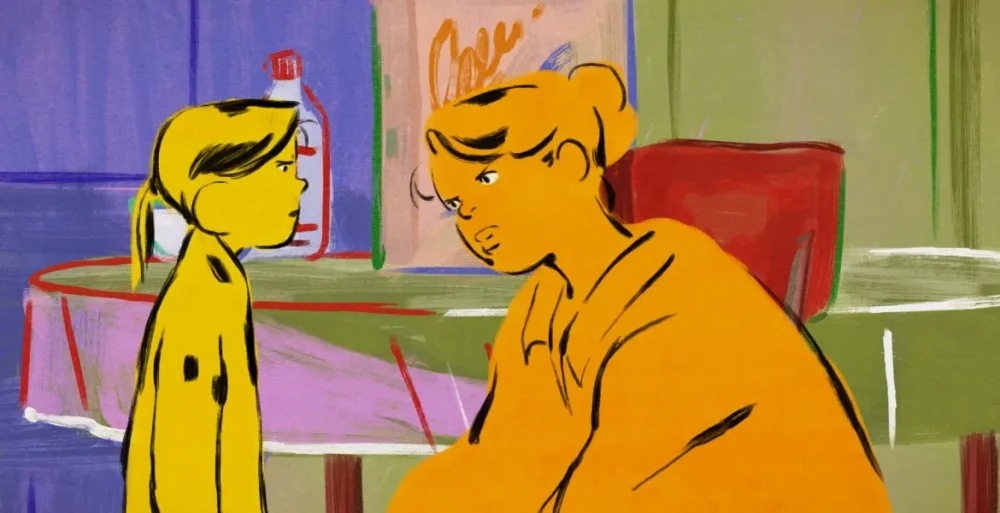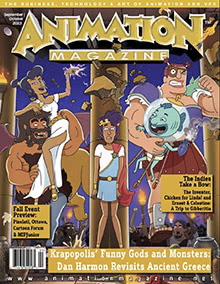|
Getting your Trinity Audio player ready...
|
After taking home the Cristal for best feature film and Grand Foundation Award at this year’s Annecy International Animation Film Festival, not long after receiving acclaim at Cannes, the upcoming French production Chicken for Linda! is shaping up to be one of the year’s most beloved indie features. Produced by Dolce Vita Films and Miyu Productions and co-directed and co-written by Chiara Malta and Sébastien Laudenbach and the film follows a mother and daughter as they try and find a chicken to eat on the day of a general strike.
“We wanted to work around childhood and children,” Malta says about the beginnings of the project. “It seemed to us that injustice was something that all children experienced, so that was our base.” Laudenbach continues, “And we had the feeling that films aimed at children often took them for fools. We wanted to make a film that is accessible to children, like the jam jar placed a little too high on the kitchen cabinet: you have to make an effort to reach it.”
Reflecting on the film’s strike element, Laudenbach says, “Perhaps adults will be more sensitive to the question of strikes and demonstrations. The strike is a dramatic spring that serves our adventure, but also expression of a feeling of injustice that the children can understand.”

Loss and Remembrance
Chicken for Linda! isn’t just about the impact of the strike, but also about a young girl trying to remember her deceased father. The main reason for the chicken hunt is to prepare a dish that he used to make her. Laudenbach says, “The question of mourning is mainly told by a lost memory. It is striking how quickly a child forgets; death is something very distant for children. We wanted to work with contrasts, bringing together beauty and comedy, laughter and drama. This undoubtedly comes from my Italian origins and from all the films of the ‘50s or ‘60s in which we often talk about serious things with a lot of irony and fun. This speaks to children, but also to adults.”
The film’s stylized presentation feels like an evolution of the minimalist style of the director’s previous feature, The Girl without Hands. As Malta notes, “Chicken for Linda! was written before The Girl without Hands. When I saw that film, I thought the time had come for this new project. There was the possibility of playing fully with the lines and the colors, with all that animation can offer as a palette.”
To match the form of the project with its rebellious themes, Laudenbach wanted to stay away from a classic animated film format with a big budget. He explains, “The style developed for The Girl was quite relevant, we pushed it a little further towards something more pop. We also needed it to be inexpensive, in order to maintain a free, unconventional tone.”

‘We wanted to make a film that is accessible to children, like the jam jar placed a little too high on the kitchen cabinet: you have to make an effort to reach it.’
— Director Sébastien Laudenbach
To do so, they worked with a small Franco-Italian team at Miyu’s studio in Paris, with less than 10 animators and a few trainees. Laudenbach says, “This created a very family atmosphere, very artisanal, everyone looked at everyone’s work, each being in charge of a complete sequence. It took about 12 months of animation. Being gathered in the same place and being a small group meant comfort and quality of work.”
The team also did extend a bit further than Paris. “Two people in the south of France did the sets: Margaux Duseigneur and Antoine Marchalot. Even if they haven’t come to Paris often, the smallness of the team means that everything is fluid,” he adds.
“Duseigneur’s very colorful style was all we needed,” says Malta. “She worked out a kind of non-figurative color script from the screenplay, which was the basis of all the backgrounds of the film.” Laudenbach adds, “They might look like paintings made by a child, but they’re actually very elaborate. She also had to think of all her compositions according to the principle of having a single color per character, which was a very strong constraint and sometimes complex to manage.”


The decision to use a single color per character also linked back to reducing cost, but this choice also had thematic purpose. Malta notes, “It reinforced the playful aspect: one color, always the same, per character, also allows you to play with the trace. The characters can be realistic when they are close-up, but very abstract when they are far away. There is also something childish in this approach, with a color that does not stay in the trace, that overflows.”
That childlike approach had some roots in older design work. Malta notes one source of inspiration as the work of Bruno Munari, an Italian designer of the ’60s and ’70s. “He worked a lot for children and with children, mixing theory and play. His work is remarkable.” She adds, “If his book Fantasia were given to all students in art school, teachers could retire!”
Their chosen fluidity of approach extended to sound as they recorded on location in schools, apartment landings and outdoor spaces. Malta notes, “The actors are not just voices, but characters interpreted freely, moving, jumping, running. This is to create a feeling of life, from the meeting between the written page and the reality of filming without camera.” Laudenbach explains, “Coupled with a use of foam props to help guide the young performers, the method allowed the dialog to be alive, with improvisation, stolen moments, presences and breaths.”
Beyond the sounds of movement and voice, Chicken for Linda! also contains a number of songs, with Clément Ducol on composition duties. Malta notes, “The songs were written from the start We had composed small pieces of music because we needed a melodic support to write the texts, but we did not let Clément hear it, who was free to compose as he wished.”

Bittersweet Melody
The songs also echo the film’s bittersweet approach to memory. Malta describes the film’s final song: “For the father’s song, we also wanted something quite contrasting, to talk about death on a playful tune, like in All That Jazz by Bob Fosse.”
That playfulness was key — even with more esoteric references to La Gazza Ladra (The Thieving Magpie). “We chose the opening of this one because it’s a very well-known and catchy tune, and it’s an Italian composer,” explains Laudenbach. Malta elaborates, “And Linda’s cat is called Gazza, ‘magpie.’ Moreover, it’s a tune so well known that it can be used as hold music when the policeman calls for help as any citizen would. It made us laugh. Overall, we had a lot of fun writing and directing the film.”
That sense of fun is keenly felt in the craft of Chicken for Linda! — a film that takes the perspective children seriously, without being overly serious.
Chicken for Linda! is one of the feature films screening in competition at the Ottawa International Animation Festival in September. GKIDS will release it in U.S theaters later this year.






 Win a Funko X Lilo & Stitch Prize Pack!
Win a Funko X Lilo & Stitch Prize Pack! 
